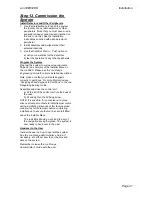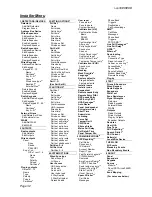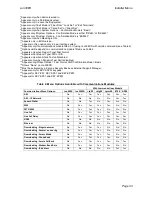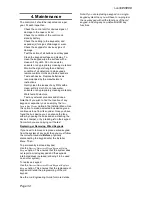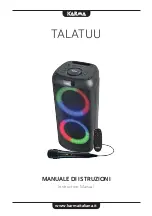
i-on30EX/EXD
Installation
Page 19
Louder
Note: This control changes the
volume of non-alarm tones (for
example Exit/Entry tone). The
volume of alarm tones is fixed.
Softer
Engineering Keypad
An Engineering Keypad is a modified i-kp01 that
can be plugged into a dedicated connector on the
control unit PCB (see 17 on Figure 2) or any of
the expanders (see 13 on Figure 14 or 10 on
Figure 16). An Engineering Keypad does not need
to be addressed, and will always be recognised by
the control unit as an engineering keypad.
You can use an Engineering Keypad to program
the system without being tied to any of the
installed keypads. If you wish to move an
Engineering keypad from one connection point to
another then you can do so without removing
power from the system.
Step 4. Fit and Connect
Expanders
Both wired and radio expanders are supplied in
the same plastic case. Use M4 25mm
countersunk screws in all three fixing holes when
mounting the back of the case on the wall. See
Figures 14 or 16 for the position of fixing holes
and cable entries.
Connecting an Expander to the Bus
Both wired and radio expanders provide a
connector for the bus at the bottom of their PCBs
(item 4 on Figures 14 and 16 ) .
Figure 26 Wiring Expanders
Addressing Expanders
The control unit assigns addresses to all devices
connected to the bus cable. You must start this
process off from the Installer Menu, during the
initial power up. See page 27 for instructions.
Expander Loudspeakers
During normal operation loudspeakers on
expanders repeat setting and entry tones for the
partition that the expander is allocated to. During
an alarm the loudspeakers repeat alarm tones.
Each loudspeaker draws up to 280mA in
operation. if there is more than one expander
loudspeaker then the bus may not be able to
supply sufficient current during an alarm.
Note that you must enable entry exit tones from
the expander loudspeakers from Installer Menu.
Step 5. Connect Control Unit
to Mains
WARNING:
ENSURE THAT THE MAINS
SUPPLY IS DISCONNECTED AND ISOLATED
BEFORE MAKING ANY MAINS CONNECTIONS.
All mains electrical connections must be carried
out by a qualified electrician and must comply with
the current local regulations (e.g. IEE).
Mains Cabling
Note: To avoid mains interference, the mains
cable must enter the control unit through its own
cable entry hole (7 in Fig 1) and must not be
mixed with other cables.
Mains Connection
Figure 27 shows the mains connection. Connect
to a suitable supply using a double pole
disconnect (isolation) device in accordance with
EN60950-1.
Caution:
Do not apply power at this point.
Anchor the mains cable with a strain-relief tie.
There is a eye located near the mains cable entry
hole for this purpose (6 in Fig 1).
Figure 27 Mains Connection
Step 6. Connect Wired Zones
The control unit and the wired expander
connectors can be used for either four-wire CCL
detectors, two-wire CCL detectors or two-wire
FSL detectors.
Four Wire Closed Circuit Connections
Figure 28 shows the wiring for four-wire CCL
zones on the control unit.
Figure 29 shows the wiring for four-wire CCL
zones on the wired expander. Note that the
Содержание i-on30EX
Страница 1: ...i on30EX i on30EXD Security System Installation Guide Issue 6...
Страница 4: ...i on30EX EXD Page iv This page is intentionally blank...
Страница 42: ...i on30EX EXD Page 38 NOTES...
Страница 43: ...i on30EX EXD Page 39 NOTES...



























